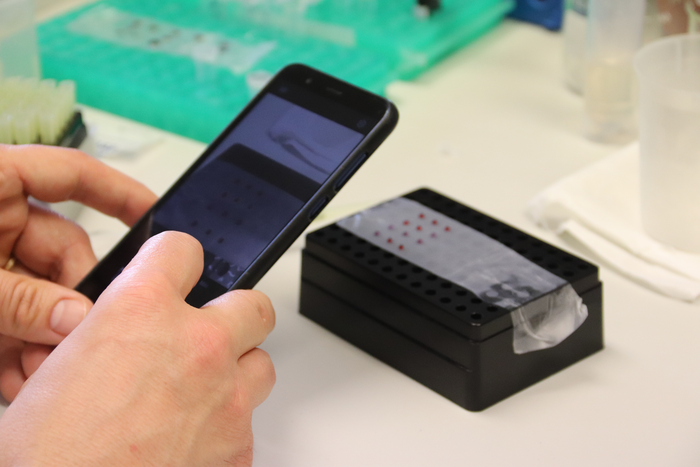Simply and quickly detect gluten in food using a cellphone
The system designed by the UPV team is a color test in which the change of color—in this case, turning red—indicates the presence of gluten

[May 17, 2022: Luis Zurano, Universitat Politècnica de València]
The system designed by the UPV team is a color test in which the change of color—in this case, turning red—indicates the presence of gluten in the food. (CREDIT: UPV)
"Our prototype is designed to help control foods from the moment they are produced, in such a way that when they reach the table, they are one hundred percent safe for the consumer, which in this case, is people who suffer from celiac disease. Its main advantage is how easy it is to use and its response times.
Today, specialized staff is required to do this analysis. Among other processes, a sample must be taken to the laboratory, which takes at least five hours to get the result; whereas with our system, we can know whether or not a food has gluten in fewer than two hours," indicates Luis A. Tortajada Genaro, researcher from the IDM Institute of the Universitat Politècnica de València. María Isabel Lucío and Ángel Maquieira, both of whom work at the IDM Institute, have participated in developing this system along with Luis A. Tortajada Genaro.
The system designed by the UPV team is a color test in which the change of color—in this case, turning red—indicates the presence of gluten in the food. "The process is very simple: we take a food sample, we grind it up, extract the DNA and amplify it. Once the sample has been prepared, we mix it in a vial with gold nanoparticles, and in just 10 minutes, it's ready to measure and that's where the cell phone comes into play," described Tortajada.
Similar to the antigen tests that are so en vogue today, to analyze a food with this method from UPV, you only need three droplets of the sample, which are deposited on a plastic membrane, which you then take a picture of with your cell phone. "Based on the apps available on the market, we can break the color down into three primary colors: red, green and blue—the RGB breakdown. The redder it is, the more gluten concentration there is in that food. Thus, in a fast and simple way, we can detect whether or not there is gluten in the food, and even its concentration level," Tortajada pointed out.
Related Stories:
Preventing fraud in meat products
In addition, for the detection of gluten, the team from the IDM Institute has applied this new test to prevent fraud in the food industry, specifically to detect possible adulterations of meat products.
"During the preparation of certain meat products, to improve its properties, grains are added, even though the regulations establish a limit. In our case, we apply the test to detect a specific gene from these grains, with the objective of controlling it to not exceed that maximum quantity," explained Luis A. Tortajada.
For the UPV researcher, the results obtained in their laboratories in both cases "show that the biodetection system developed is very competitive, and it allows for better product control. It is a system that responds to the demands of the food industry and consumers and contributes to guarantee food quality at all times, following the 'from farm to fork' strategy," concluded Tortajada.
For more technology news stories check out our New Innovations section at The Brighter Side of News.
Note: Materials provided above by Universitat Politècnica de València. Content may be edited for style and length.
Like these kind of feel good stories? Get the Brighter Side of News' newsletter.
Tags: #New_Innovations, #Mobile_App, #AI, #Health_News, #Gluten, #Digital_Health, #Science, #Research, #Technology, #The_Brighter_Side_of_News
Joseph Shavit
Head Science News Writer | Communicating Innovation & Discovery
Based in Los Angeles, Joseph Shavit is an accomplished science journalist, head science news writer and co-founder at The Brighter Side of News, where he translates cutting-edge discoveries into compelling stories for a broad audience. With a strong background spanning science, business, product management, media leadership, and entrepreneurship, Joseph brings a unique perspective to science communication. His expertise allows him to uncover the intersection of technological advancements and market potential, shedding light on how groundbreaking research evolves into transformative products and industries.



